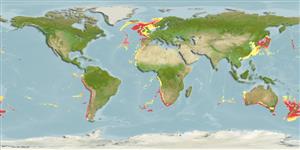Elasmobranchii (sharks and rays) >
Squaliformes (Bramble, sleeper and dogfish sharks) >
Centrophoridae (Gulper sharks)
Etymology: Deania: From B. Dean (1916), ichthyiologist and researcher of ichtyiological bibliography (Ref. 45335).
Environment / Climate / Range
Ecology
Marine; bathydemersal; depth range 60 - 1490 m (Ref. 26346), usually 400 - 1400 m (Ref. 10717). Deep-water, preferred 20°C (Ref. 107945); 70°N - 56°S, 180°W - 180°E
Eastern Atlantic: Iceland along Atlantic slope to Algoa Bay, South Africa (Ref. 247, 5578). Western Pacific: southern Honshu in Japan, southern Australia, New Zealand. Occurrence in the Western Central Pacific uncertain (Ref. 31367). Eastern Pacific: southern Chile to northern Peru (Ref. 38549).
Length at first maturity / Size / Weight / Age
Maturity: Lm 105.0, range 70 - 111 cm
Max length : 122 cm TL male/unsexed; (Ref. 26346)
Found on the outer continental and insular shelves and upper slopes (Ref. 247). Usually on or near the bottom but sometimes found well above it (Ref. 5578). Apparently in large schools (Ref. 5578). Feeds on pelagic bony fish, squid, octopus and shrimp (Ref. 5578). Ovoviviparous (Ref. 50449). Caught very rarely by demersal longline fisheries operating in deepwater of Indonesia. Utilized for its meat, fins (low value) and liver oil (very high value) (Ref. 58048).
Ovoviviparous, embryos feed solely on yolk (Ref. 50449). Young possibly number 6 to 12 in a litter, as these were the number of fertilized eggs found in the uteri of some specimens (Ref. 247). Size at birth 29 to 34 cm (Ref. 26346). Distinct pairing with embrace (Ref. 205).
Compagno, L.J.V., 1984. FAO Species Catalogue. Vol. 4. Sharks of the world. An annotated and illustrated catalogue of shark species known to date. Part 1 - Hexanchiformes to Lamniformes. FAO Fish. Synop. 125(4/1):1-249. Rome, FAO. (Ref. 247)
IUCN Red List Status (Ref. 115185)
CITES (Ref. 94142)
Not Evaluated
Threat to humans
Harmless
Human uses
Fisheries: minor commercial
More information
ReferencesAquacultureAquaculture profileStrainsGeneticsAllele frequenciesHeritabilityDiseasesProcessingMass conversion
Tools
Special reports
Download XML
Internet sources
Estimates of some properties based on models
Phylogenetic diversity index (Ref.
82805): PD
50 = 0.5625 [Uniqueness, from 0.5 = low to 2.0 = high].
Bayesian length-weight: a=0.00224 (0.00108 - 0.00465), b=3.14 (2.95 - 3.33), in cm Total Length, based on LWR estimates for this species & (Sub)family-body (Ref.
93245).
Trophic Level (Ref.
69278): 4.3 ±0.4 se; Based on diet studies.
Resilience (Ref.
69278): Very Low, minimum population doubling time more than 14 years (K=0.077-0.135; Fec=6-12; tm=25).
Vulnerability (Ref.
59153): High to very high vulnerability (66 of 100) .
